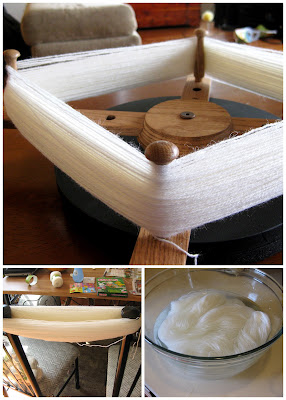With Easter near on the horizon, and today being Good Friday and all, I thought it was time to post my most recent crafting experience. Easter Eggs!
I used the classic Paas egg dye, where you dissolve tabs in vinegar, then add water.
I tried to keep it nice and clean, but dying eggs always makes such a mess.
Supposedly dissolving the tabs in vinegar before adding water makes the colors brighter. I'm not sure I believe it. Somebody needs to show me the science on that. Or maybe I should just perform an experiment after Easter when all the egg dye kits go on sale.
Aren't they pretty? Don't they make you hungry?
.... for chocolate? Yum, Easter.
I only dyed nine eggs. I thought more than that wouldn't get eaten in a reasonable time period. So, what to do with all the dye after it's done?
Dye yarn!
I found this article about how to do it successfully and followed it pretty closely.
I started with a light cream colored yarn that I thought would take the color nicely. When dying yarn you should always use natural fibers - acrylic yarn does not accept dye. Unfortunately, this AlpacaWare Blended Alpaca is 50% acrylic, 30% alpaca, 20% wool. I didn't know what to expect, but I have 10 skeins of this stuff, so I decided if it was super ugly I wouldn't mind tossing it. And what fun would it be if the yarn turned out with 1 ply white and 1 ply dyed??
To prep the yarn, I re-wound the skein into a hank to make sure all of the yarn had equal access to the dye. The first ball I used the backs of two chairs, but that was a bit tedious. For the next two I used my Handmade by Rich yarn swift, and that was a bit quicker and easier. Next, you soak your hanks in water for 20 minutes.
As far as color goes, I really wanted to use purple and gold for obvious reasons, but I have heard from various sources that purple dyes are really hard to get right. They often turn parts of the skein red and parts blue, or just make them splotchy and not very attractive. So instead I chose blue, green, and red.
I drained the water from the soaking bowls, poured in the egg dye (the very same stuff I used on my eggs earlier in the day), and filled the bowls with water until the yarn was just covered.
The instructions say that, depending on the yarn, it can take anywhere from 20 minutes to a couple hours for the dye to soak in, and you will know it's done when all of the dye is absorbed and the water runs clear. After several hours my water still had color, so I left the hanks soaking overnight.
The next day, I gently poured out the water and rinsed the yarn. Surprisingly, the blue dye had all been absorbed while both the red and the green still tinted the water. Once rinsed until the water ran clear, I hung the hanks on hangers in my tub to dry.
The resulting colors were Easter pastel spring colors. How fitting! If I had to make a guess, I would say that more dye would have been absorbed and the colors would have been much brighter had I used 100% natural yarn. But I like the end result, and now have to find suitable projects for them. Maybe I'll have to find a baby project that only requires 150 grams of fingering weight yarn.
Next I'm going to try dying yarn with Kool-Aid!









No comments:
Post a Comment